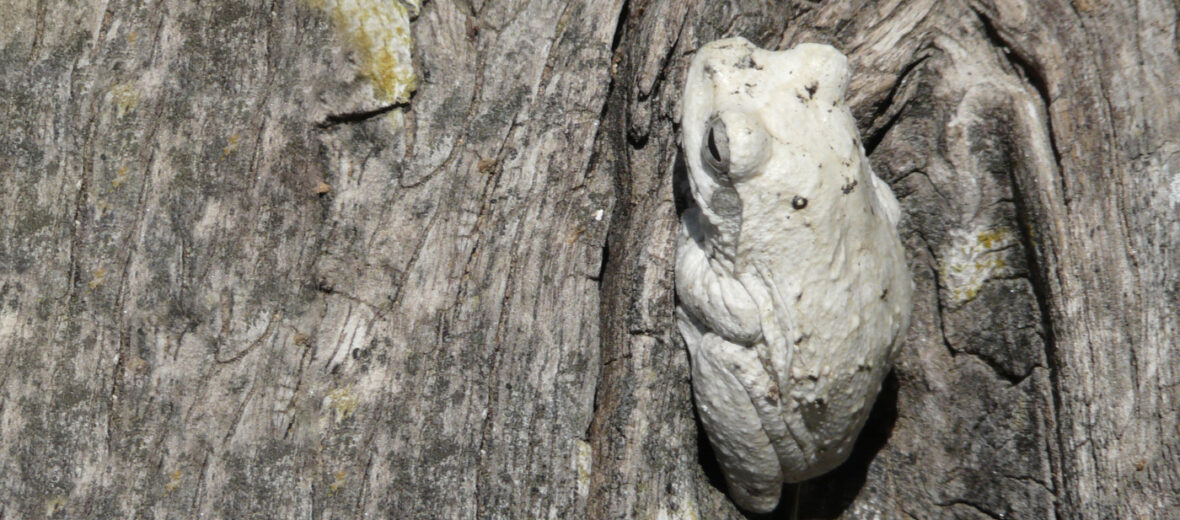
The grey foam-nest tree frog, aka southern foam-nest tree frog, hails from South Africa. The frogs are very adaptable and can tolerate a wide variety of habitats like ponds, canals, ditches, subtropical and tropical dry forests, dry and moist savannas, shrublands, lowland grasslands, seasonally wet and/or flooded lowland grasslands, intermittent freshwater marshes, arable lands, pasturelands, rural gardens, urban areas, and heavily degraded former forests. These frogs don’t face any substantial natural threats, sans the potential for habitat loss, pollution, and collection for the pet trade. The IUCN lists these tree frogs as Least Concern. Their population trend is unknown.
First the Stats…
Scientific name: Chiromantis xerampelina
Weight: Up to 1 ounce
Length: Up to 3.54 inches
Lifespan: Up to 7+ years
Now on to the Facts!
1.) These frogs are arboreal (spend their lives in trees and/or bushes).
2.) Unlike other frogs, these tree frogs have only semi-impermeable skin. This affords them the ability to withstand dry spells for longer than other frog species.
3.) Grey foam-nest tree frogs are considered to be habitat specialists, which is in reference to a species known to only breed within unperturbed areas as well as unsettled environments.
4.) Like other tree frogs, these critters are nocturnal (active at night).
5.) The female starts the process of reproduction by producing a thick mucus-like fluid from her cloaca (rectal opening found in reptiles and amphibians).
But wait, there’s more on the grey foam-nest tree frog!
6.) Females utilize their hind legs to whip the mucous into an elastic froth that will eventually serve as protection for the soon to be developing eggs.
7.) Nest production can take up to 6 hours.
Did you know…?
Over 90% of the female frogs mate with 10 or more males to produce a single egg clutch.
8.) These frogs engage in simultaneous polyandry (1 female mates with more than 1 male at the same time).
9.) Once the eggs are laid and fertilized, it’s the male who watches over the brood and guards the developing eggs from predators.
10.) Some grey foam-nest tree frogs will breed exclusively in water. In this scenario, the foam nests allow the eggs to be suspended in oxygenated water.
But wait, there’s still more on the grey foam-nest tree frog!
11.) The tree frogs that build their nest on land create these nests to reduce drying out, temperature changes, and predation.
12.) Polyandrous mating is thought to provide eggs with additional nutrients via the seminal fluid from multiple males. This increases the chances of reproductive survival over that of monogamous (mate for life) animals.
Did you know…?
The uric acid excreted from these frogs is often released in a solid form and doesn’t end up causing any water loss for the frog.
13.) Females lay upward of 1,250 eggs in nests that are intentionally built overhanging a water source.
14.) The eggs develop into tadpoles in up to 6 days. The tadpoles then break free of the foam nest and drop into the water below to continue developing for another 6 – 8 weeks.
15.) Grey foam-nest tree frogs produce uric acid and excretes it from their body in a nitrogenous end product. Anywhere between 50% – 75% of their total waste nitrogen is transformed into uric acid, while the remaining amount is expelled as urea in their waste.
But wait, there’s still a little more on the grey foam-nest tree frog!
16.) In response to temperature fluctuations, these frogs can change the coloration and patterning of their skin from a chalky grey color to a molted, patterned brown bark-looking coloration.
17.) Due to their water loss resistant skin, these frogs are often called “waterproof frogs”.
18.) They also have the ability to secrete a water-resistant mucus to seal in any small, exposed gaps when they aestivate (hibernation for amphibians).
19.) Another cool survival adaptation is that these frogs can lose up to 60% of their body weight in response to less available food.
20.) Their primary predator is the Fornasini’s spiny reed frog, who is known to prey on the eggs and/or tadpoles.
Now a Short Grey Foam-Nest Tree Frog Video!
This video talks about foam-nest frogs in general.
Be sure to share & comment below! Also, check out the Critter Science YouTube channel. Videos added regularly!
Want to suggest a critter for me to write about? Let me know here.
Some source material acquired from: Wikipedia & IUCN
Photo credit: Simon J. Tonge



